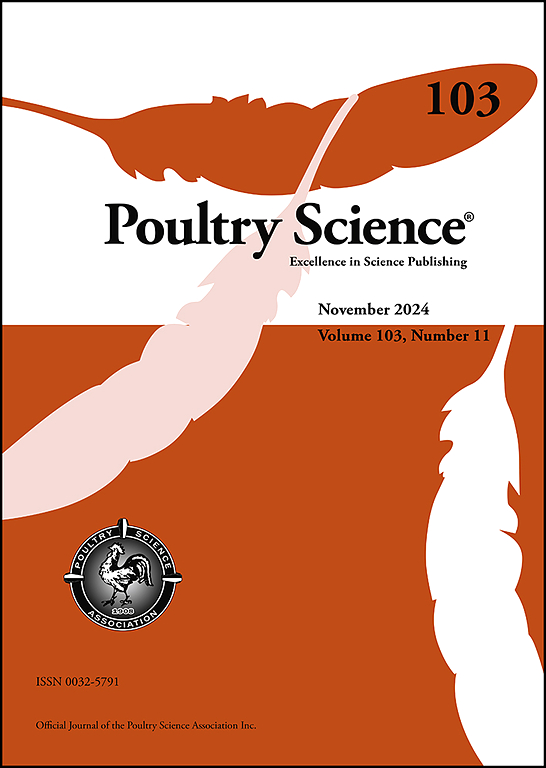鹅结肠眼睑候选基因多态性位点的筛选及其在表型纯化中的应用。
IF 4.2
1区 农林科学
Q1 AGRICULTURE, DAIRY & ANIMAL SCIENCE
引用次数: 0
摘要
本研究旨在筛选、验证和应用与眼睑缺陷相关的候选基因(FREM1和PTPRM)的分子标记,为建立霍岩鹅自性系奠定基础。以150只1 d龄火雁(其中100只为双眼皮鹅,50只为正常眼皮鹅)为研究对象,在FREM1转录本1和转录本2上游1kb序列中分别鉴定出6个和3个多态位点单核苷酸多态性(snp)。所有鉴定的snp均与结肠眼睑性状有显著相关性(P < 0.05)。为了进一步研究这些snp的调控作用,在鹅原代肝细胞和肌细胞中进行的双荧光素酶报告基因检测证实,转录本1中SNP2位点(c -385 A > T)和转录本2中SNP3位点(c -714 A > G)的突变分别显著增强或抑制FREM1的表达(P < 0.05)。随后,生物信息学分析预测SNP2位于Pou1f1的结合序列内,SNP3位于CUX2的结合序列内。1 μmol/L地塞米松组诱导FREM1表达(P < 0.05), 75 μmol/ mL利福平组抑制FREM1表达(P < 0.05)。实时荧光定量PCR分析显示,正常眼睑和野生型基因型的霍雁雌性眼睑和肝脏组织中FREM1的表达量均显著高于结肠眼睑和突变型(P < 0.05)。基于本研究发现的FREM1关键多态性位点,结合之前发现的PTPRM关键位点,通过标记辅助选择,使双眼皮率增加,在303个后代中达到97.03%。综上所述,本研究结果强烈支持FREM1和PTPRM是结肠眼睑性状的致病基因;获得的分子标记可显著提高选择效率;FREM1上游序列中关键SNP位点的突变可以通过影响推测的转录因子Pou1f1和CUX2的结合亲和力来改变其表达。本文章由计算机程序翻译,如有差异,请以英文原文为准。
Screening of polymorphic loci in candidate genes for colobomus eyelid and their application in phenotypic purification of geese
This study was to screen, verify and apply molecular markers of candidate genes (FREM1 and PTPRM) related to eyelid defect, which may facilitate establishment of autosexing strains of Huoyan goose. Using 150 1-d-old Huoyan geese containing 100 with colobomus eyelid and 50 with normal eyelid, 6 and 3 polymorphic loci single nucleotide polymorphisms (SNPs) were identified in the 1-kb upstream sequences of FREM1 transcript 1 and transcript 2, respectively. All identified SNPs showed significant association with the colobomus eyelid trait (P < 0.05). To further investigate the regulatory effects of these SNPs, dual-luciferase reporter assays in goose primary hepatocytes and myocytes confirmed that mutations at SNP2 locus (c.-385 A > T) in transcript 1 and SNP3 locus (c.-714 A > G) in transcript 2 significantly enhanced or suppressed FREM1 expression, respectively (P < 0.05). Subsequently, bioinformatics analysis predicted that SNP2 was located within the binding sequence of Pou1f1, and that SNP3 was located within the binding sequence of CUX2. Treatment with 1 μmol/L dexamethasone (drug for Poulf1) induced FREM1 expression (P < 0.05), and treatment with 75 μg/mL rifampicin (drug for CUX2) suppressed FREM1 expression (P < 0.05). Furthermore, quantitative real-time PCR analysis revealed that female Huoyan geese with either the normal eyelid or wild type genotype exhibited significantly higher FREM1 expression in both eyelid and liver tissues of than those with the colobomus eyelid or mutant genotype, respectively (P < 0.05). Based on the key polymorphic locus in FREM1 identified in this study, combined with previously discovered key locus in PTPRM, marker-assisted selection led to an increase in the colobomus eyelid rate, reaching 97.03 % in 303 offspring. In conclusion, the findings strongly support FREM1 and PTPRM as causative genes for the colobomus eyelid trait; the obtained molecular markers can significantly improve the selection efficiency; mutations at the key SNP loci in the upstream sequences of FREM1 can alter its expression by affecting the binding affinity of the putative transcription factors, Pou1f1 and CUX2.
求助全文
通过发布文献求助,成功后即可免费获取论文全文。
去求助
来源期刊

Poultry Science
农林科学-奶制品与动物科学
CiteScore
7.60
自引率
15.90%
发文量
0
审稿时长
94 days
期刊介绍:
First self-published in 1921, Poultry Science is an internationally renowned monthly journal, known as the authoritative source for a broad range of poultry information and high-caliber research. The journal plays a pivotal role in the dissemination of preeminent poultry-related knowledge across all disciplines. As of January 2020, Poultry Science will become an Open Access journal with no subscription charges, meaning authors who publish here can make their research immediately, permanently, and freely accessible worldwide while retaining copyright to their work. Papers submitted for publication after October 1, 2019 will be published as Open Access papers.
An international journal, Poultry Science publishes original papers, research notes, symposium papers, and reviews of basic science as applied to poultry. This authoritative source of poultry information is consistently ranked by ISI Impact Factor as one of the top 10 agriculture, dairy and animal science journals to deliver high-caliber research. Currently it is the highest-ranked (by Impact Factor and Eigenfactor) journal dedicated to publishing poultry research. Subject areas include breeding, genetics, education, production, management, environment, health, behavior, welfare, immunology, molecular biology, metabolism, nutrition, physiology, reproduction, processing, and products.
 求助内容:
求助内容: 应助结果提醒方式:
应助结果提醒方式:


